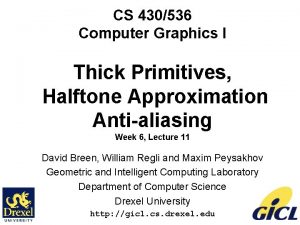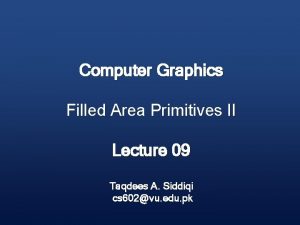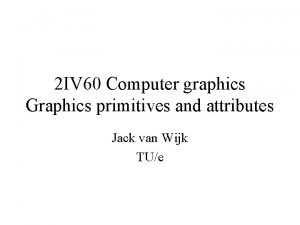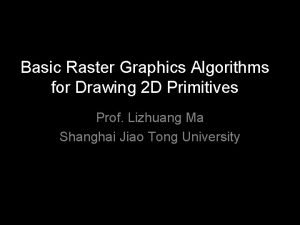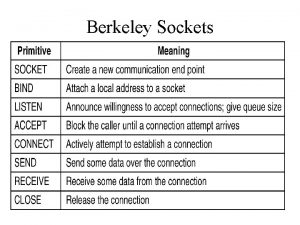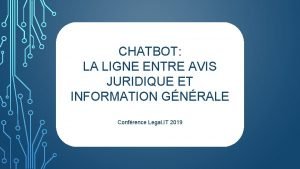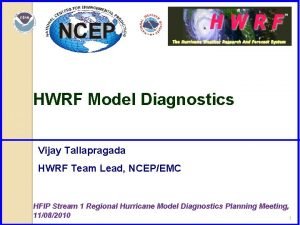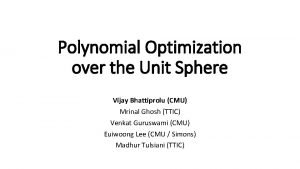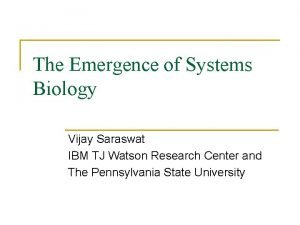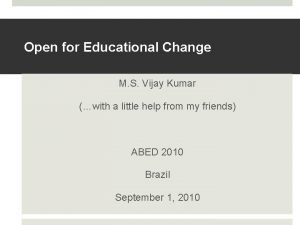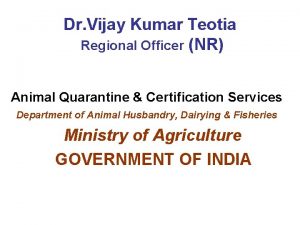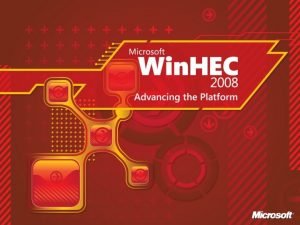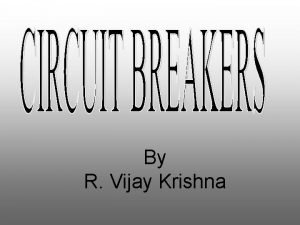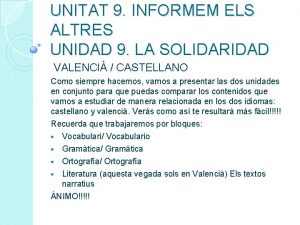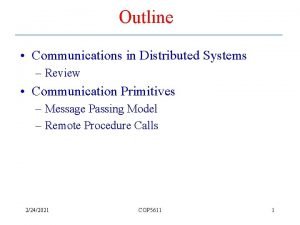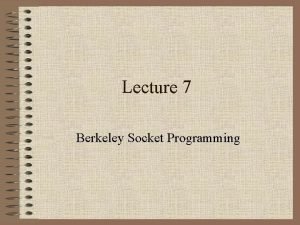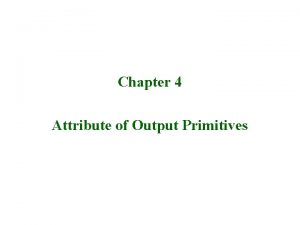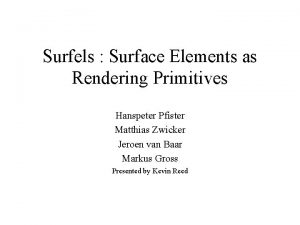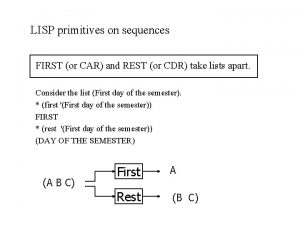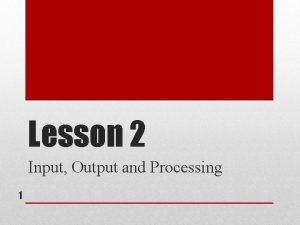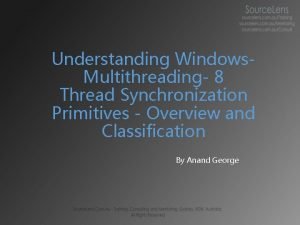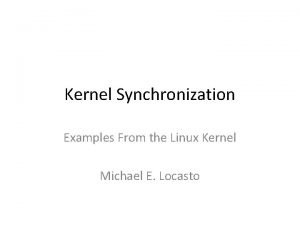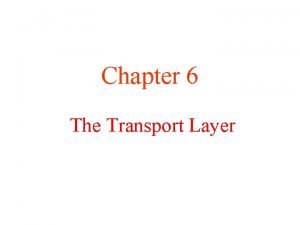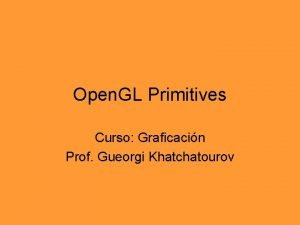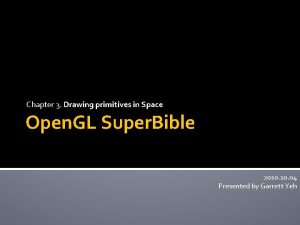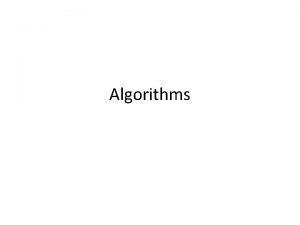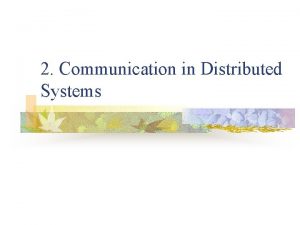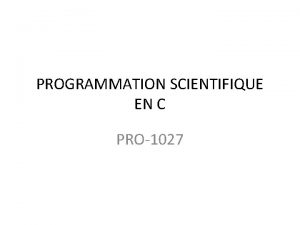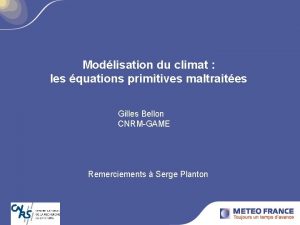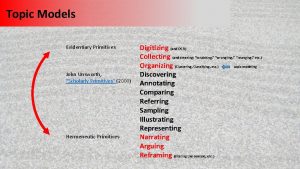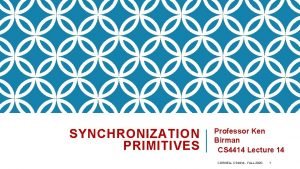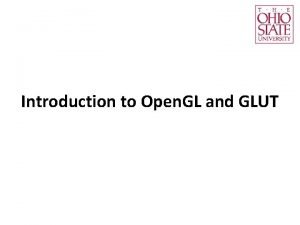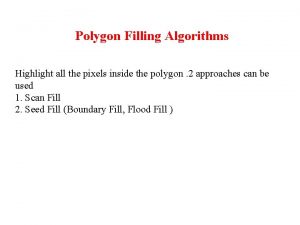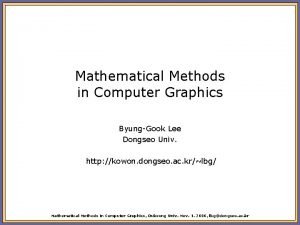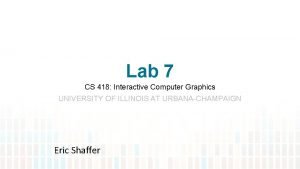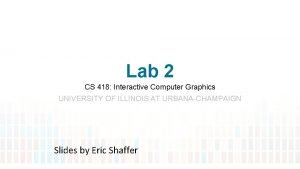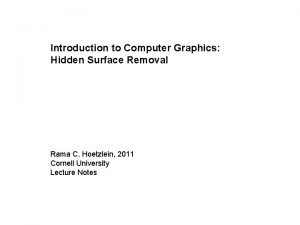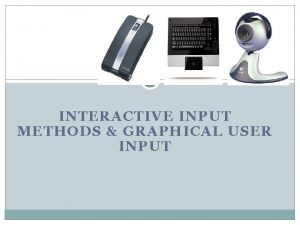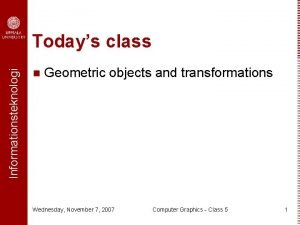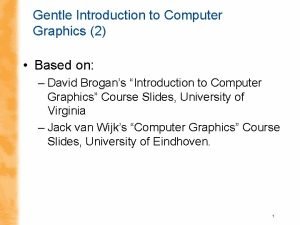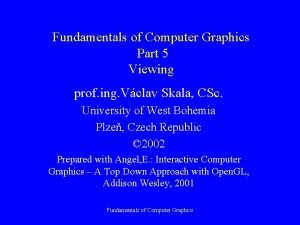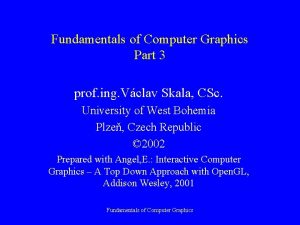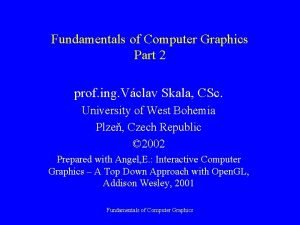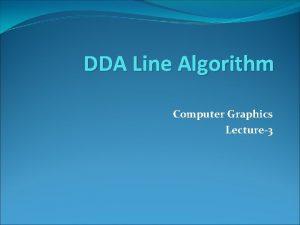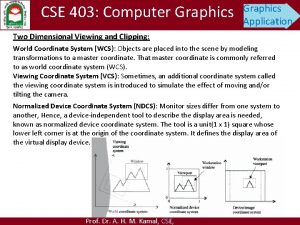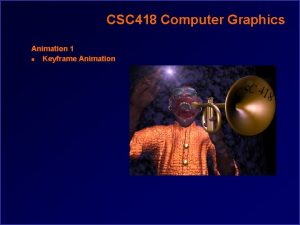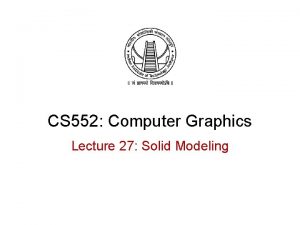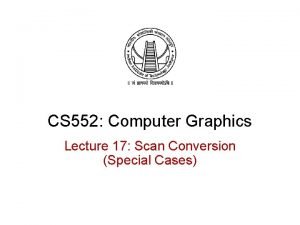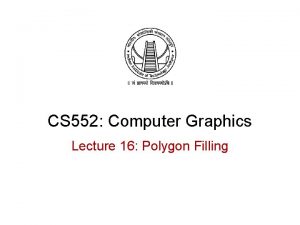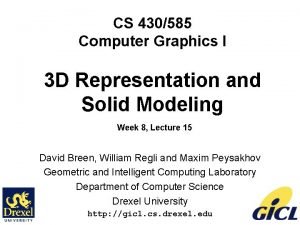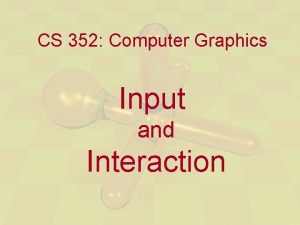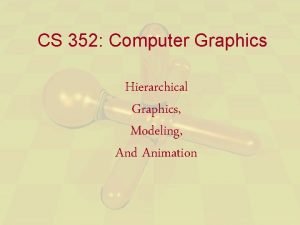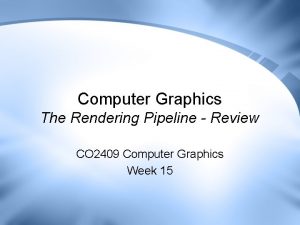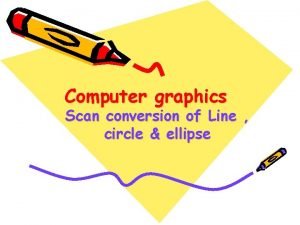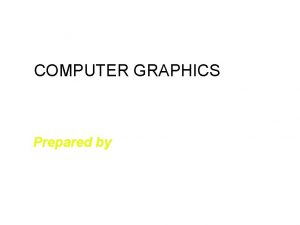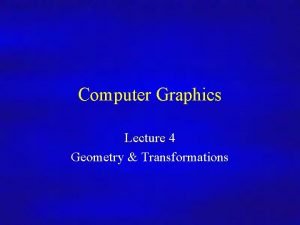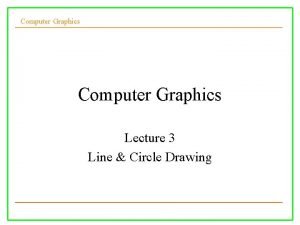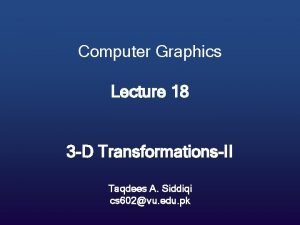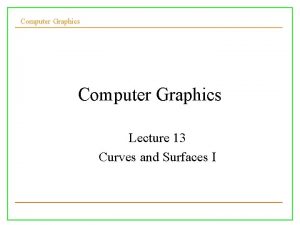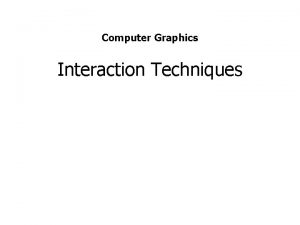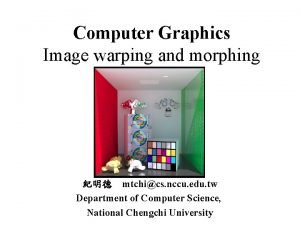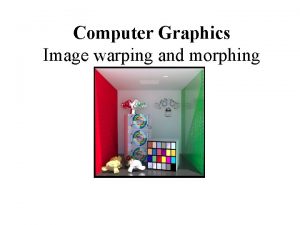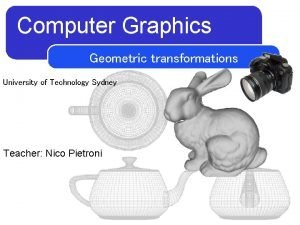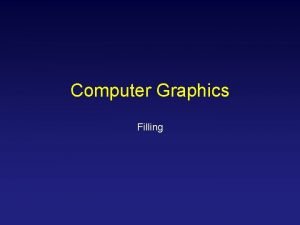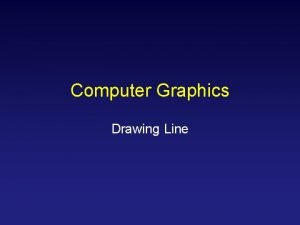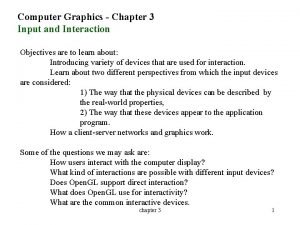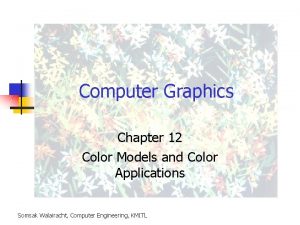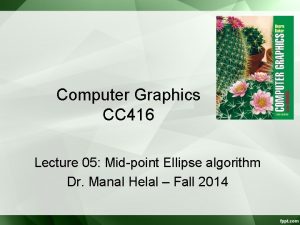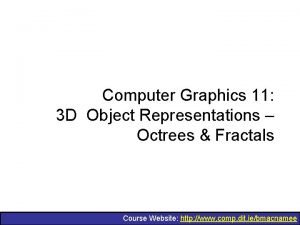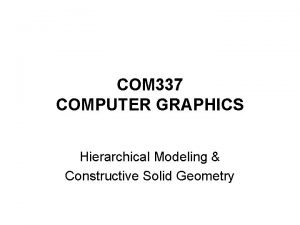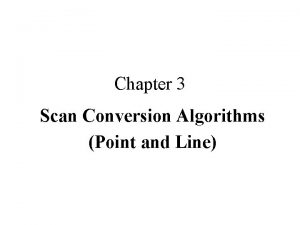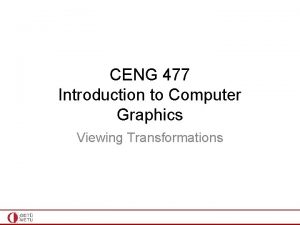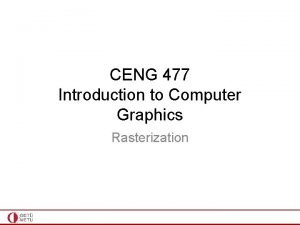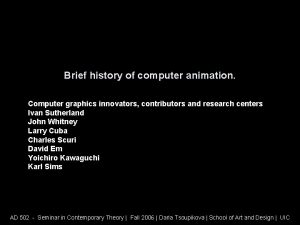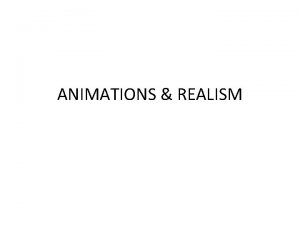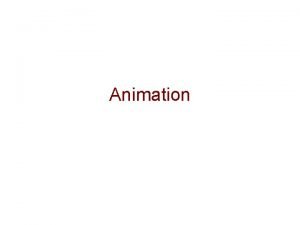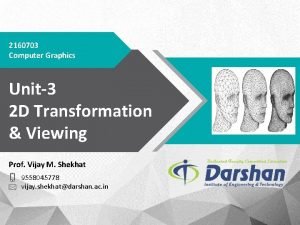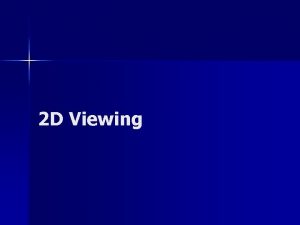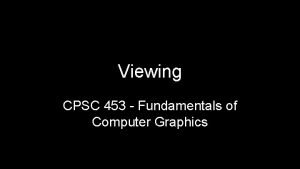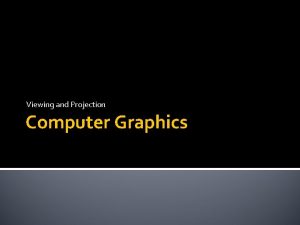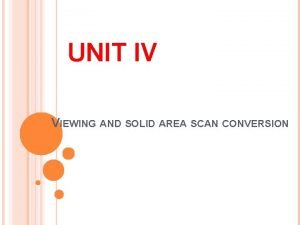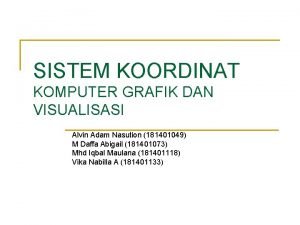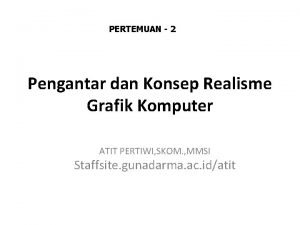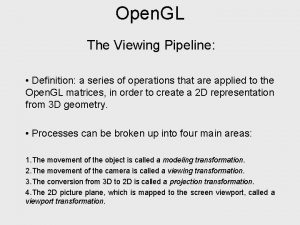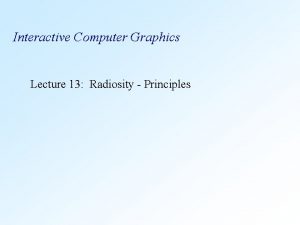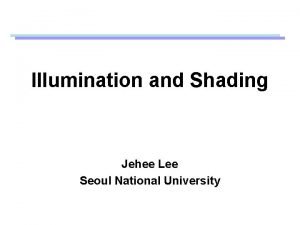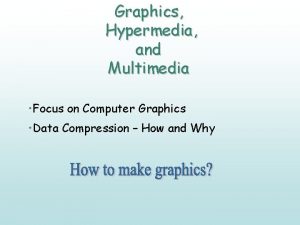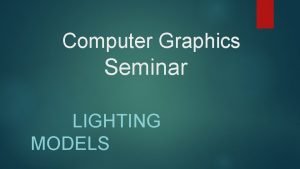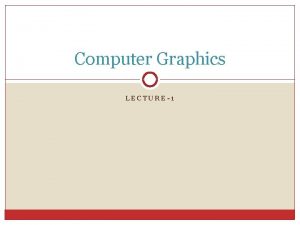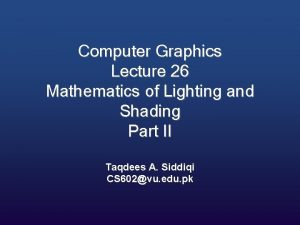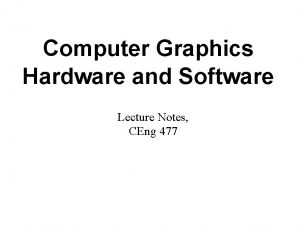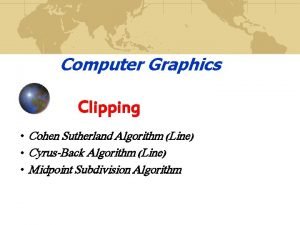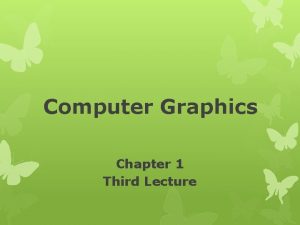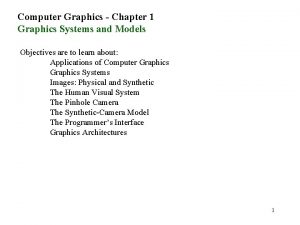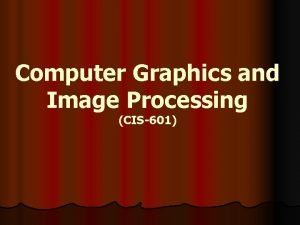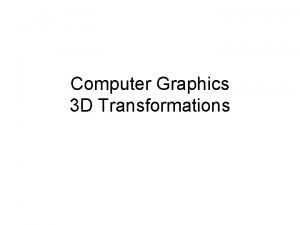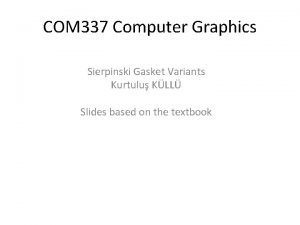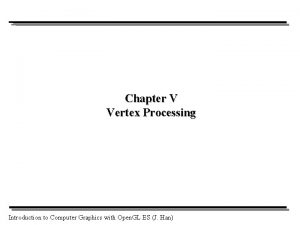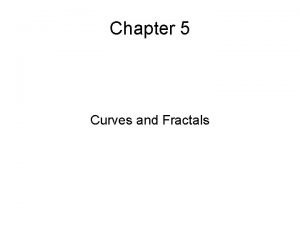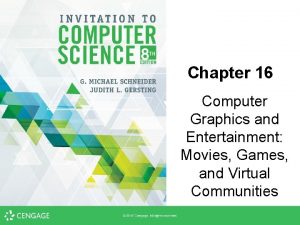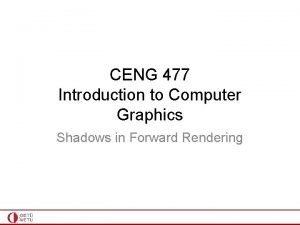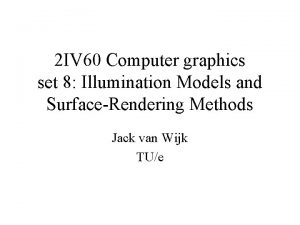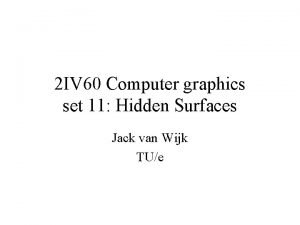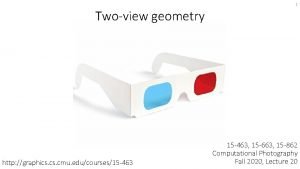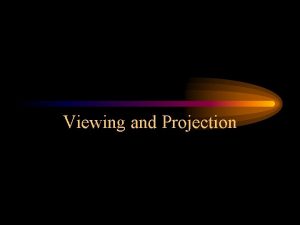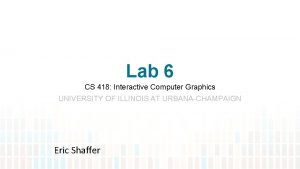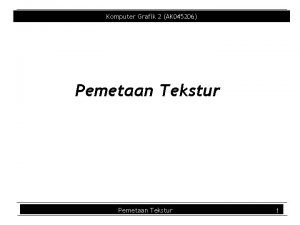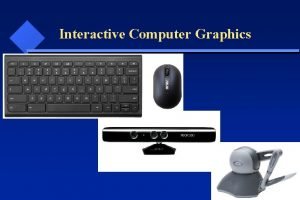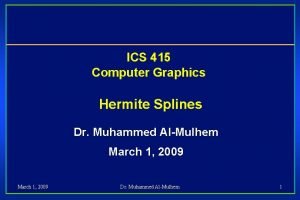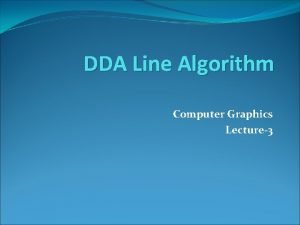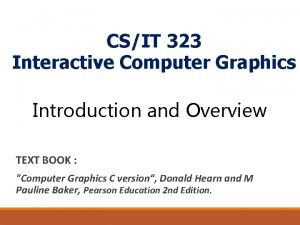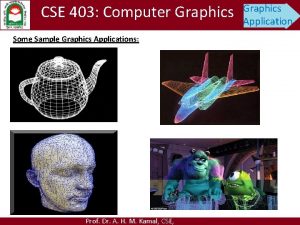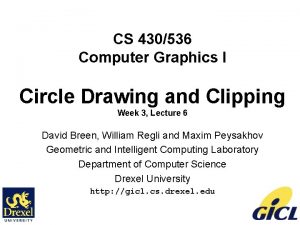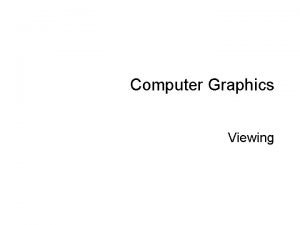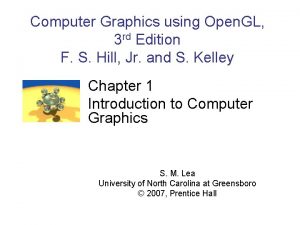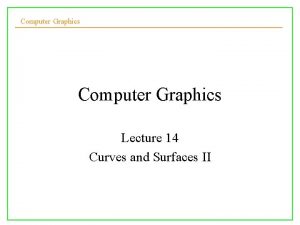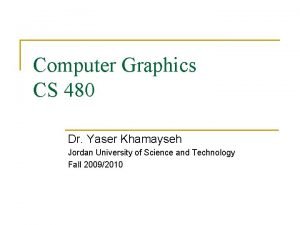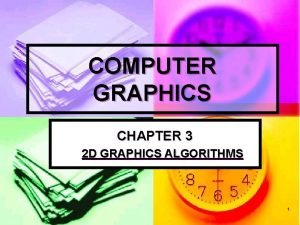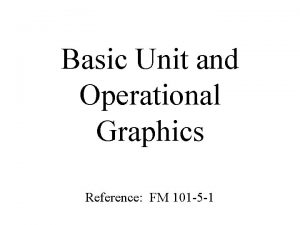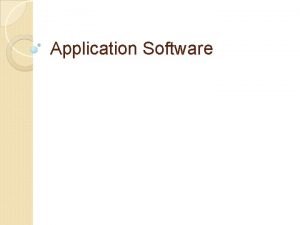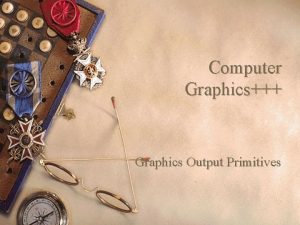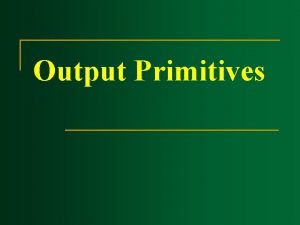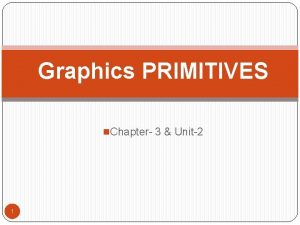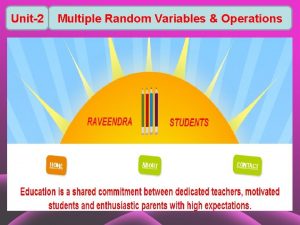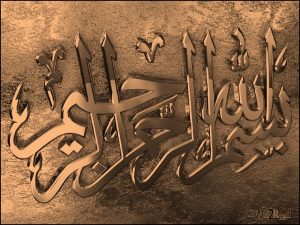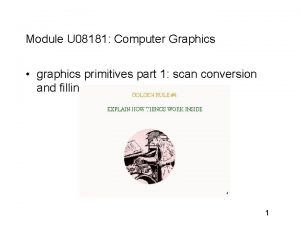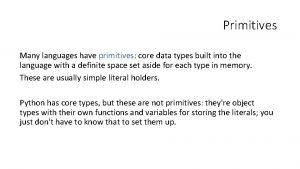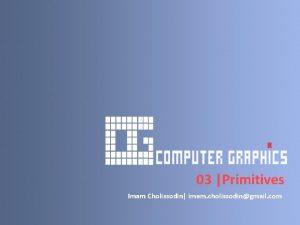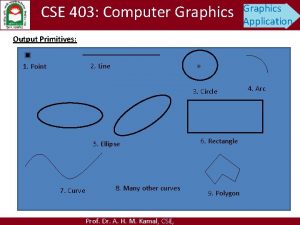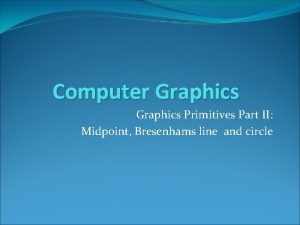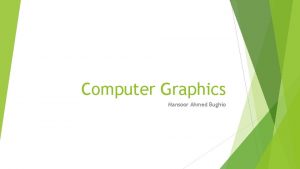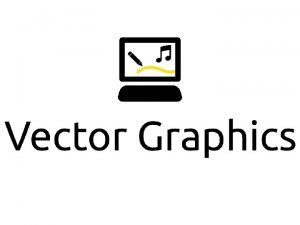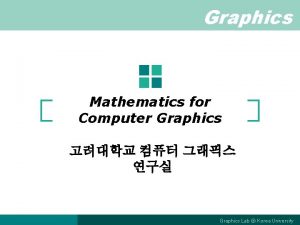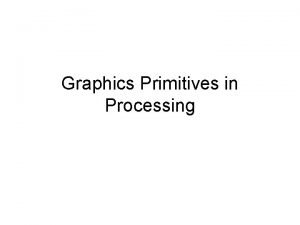2160703 Computer Graphics Unit2 Graphics Primitives Prof Vijay
































































































































































- Slides: 160

2160703 Computer Graphics Unit-2 Graphics Primitives Prof. Vijay M. Shekhat 9558045778 vijay. shekhat@darshan. ac. in

Outline § § § § Points Line drawing algorithms. Circle drawing algorithm. Ellipse drawing algorithm. Scan-Line polygon filling algorithm. Inside-Outside test. Boundary fill algorithm. Flood fill algorithm. Character generation. Line attributes. Color and grayscale levels Area fill attributes. Character attributes. Unit: 2 Graphics Primitives 2 Darshan Institute of Engineering & Technology

Point § 7 6 5 4 3 2 1 0 0 1 2 Unit: 2 Graphics Primitives 3 3 4 5 6 7 Darshan Institute of Engineering & Technology

Line § Line drawing is done by calculating intermediate positions along the line path between two specified endpoint positions. § The output device is then directed to fill in those positions between the end points with some color. 5 5 § For some device such as a pen plotter or random scan display, a 4 4 straight line can be drawn smoothly from one end point to other. 3 3 2 2 § Digital devices display a straight line segment by plotting discrete 1 1 points between the two endpoints. 0 0 0 2 4 6 § Discrete coordinate positions along the line path are calculated from the equation of the line. 1 2 Unit: 2 Graphics Primitives 4 3 4 Darshan Institute of Engineering & Technology

Contd. § Screen locations are referenced with integer values. § So plotted positions may only approximate actual line positions between two specified endpoints. For example line position of (12. 36, 23. 87) would be converted to pixel position (12, 24). § This rounding of coordinate values to integers causes lines to be displayed with a stair step appearance (“the Jaggies”). Unit: 2 Graphics Primitives 5 Darshan Institute of Engineering & Technology

Line Drawing Algorithms § Unit: 2 Graphics Primitives 6 Darshan Institute of Engineering & Technology

Introduction to DDA Algorithm § Unit: 2 Graphics Primitives 7 Darshan Institute of Engineering & Technology

Unit Step Direction in DDA Algorithm § Processing from left to right. ü Slope is “+ve”, & Magnitude is Less than 1 ü Slope is “-ve”, & Magnitude is Less than 1 ü Slope is “+ve”, & Magnitude is greater than 1 ü Slope is “-ve”, & Magnitude is greater than 1 § Processing from right to left. ü Slope is “+ve”, & Magnitude is Less than 1 ü Slope is “-ve”, & Magnitude is Less than 1 ü Slope is “+ve”, & Magnitude is greater than 1 ü Slope is “-ve”, & Magnitude is greater than 1 Unit: 2 Graphics Primitives 8 Darshan Institute of Engineering & Technology

Derivation of DDA Algorithm § Unit: 2 Graphics Primitives 9 Darshan Institute of Engineering & Technology

Contd. § Unit: 2 Graphics Primitives 10 Darshan Institute of Engineering & Technology

Procedure for DDA line algorithm. Void line. DDA (int xa, int ya, int xb, int yb) { int dx = xb – xa, dy = yb – ya, steps, k; float xincrement, yincrement, x = xa, y = ya; if (abs(dx)>abs(dy)) { Steps = abs (dx); } else { Steps = abs (dy); } xincrement = dx/(float) steps; yincrement = dy/(float) steps; setpixel (ROUND (x), ROUND (y)); for(k=0; k<steps; k++) { x += xincrement; y += yincrement; setpixel (ROUND (x), ROUND (y)); } }

Example DDA Algorithm § 4 3 2 1 0 0 1 2 3 4 5 6 7 8 Unit: 2 Graphics Primitives 12 Darshan Institute of Engineering & Technology

Introduction to Bresenham’s Line Algorithm § Unit: 2 Graphics Primitives 13 Darshan Institute of Engineering & Technology

Line Path & Candidate pixel § Example |ΔX| > |ΔY|, and ΔY is “+ve”. Ø Initial point (Xk, Yk) Ø Line path Ø Candidate pixels {(Xk+1, Yk), (Xk+1, Yk+1)} 4 3 2 1 0 0 1 2 3 4 § Now we need to decide which candidate pixel is more closer to actual line. § For that we use decision parameter (Pk) equation. § Decision parameter can be derived by calculating distance of actual line from two candidate pixel. Unit: 2 Graphics Primitives 14 Darshan Institute of Engineering & Technology

Derivation Bresenham’s Line Algorithm 4 § 3 2 1 0 0 1 2 3 4 Unit: 2 Graphics Primitives 15 Darshan Institute of Engineering & Technology

Contd. § Unit: 2 Graphics Primitives 16 Darshan Institute of Engineering & Technology

Contd. § Unit: 2 Graphics Primitives 17 Darshan Institute of Engineering & Technology

Initial Decision parameter § Unit: 2 Graphics Primitives 18 Darshan Institute of Engineering & Technology

Bresenham’s Line Algorithm § Unit: 2 Graphics Primitives 19 Darshan Institute of Engineering & Technology

Discryption of Bresenham’s Line Algorithm § Unit: 2 Graphics Primitives 20 Darshan Institute of Engineering & Technology

Example Bresenham’s Line Algorithm § 4 3 2 1 0 0 1 2 3 4 5 6 7 8 Unit: 2 Graphics Primitives 21 Darshan Institute of Engineering & Technology

Parallel Execution of Line Algorithms § The line-generating algorithms we have discussed so far determine pixel positions sequentially. § With multiple processors we can calculate pixel position along a line path simultaneously. § One way to use multiple processors is partitioning existing sequential algorithm into small parts and compute separately. § Alternatively we can setup the processing so that pixel positions can be calculated efficiently in parallel. § Balance the load among the available processors is also important in parallel processing. Unit: 2 Graphics Primitives 22 Darshan Institute of Engineering & Technology

Parallel Bresenham Line Algorithms § Unit: 2 Graphics Primitives 23 Darshan Institute of Engineering & Technology

Contd. § Unit: 2 Graphics Primitives 24 Darshan Institute of Engineering & Technology

IDP for Parallel Bresenham Line Algorithms § Unit: 2 Graphics Primitives 25 Darshan Institute of Engineering & Technology

Other Ways for Parallel Execution of Line Algorithms § Unit: 2 Graphics Primitives 26 Darshan Institute of Engineering & Technology

Contd. § Unit: 2 Graphics Primitives 27 Darshan Institute of Engineering & Technology

Contd. § Unit: 2 Graphics Primitives 28 Darshan Institute of Engineering & Technology

Contd. § Unit: 2 Graphics Primitives 29 Darshan Institute of Engineering & Technology

Circle § r Radius Unit: 2 Graphics Primitives 30 Darshan Institute of Engineering & Technology

Properties of Circle- Cartesion Coordinate § Unit: 2 Graphics Primitives 31 Darshan Institute of Engineering & Technology

Contd. § But this is not best method as it requires more number of calculations which take more time to execute. § And also spacing between the plotted pixel positions is not uniform. § We can adjust spacing by stepping through y values and calculating x values whenever the absolute value of the slop of the circle is greater than 1. § But it will increases computation time. Unit: 2 Graphics Primitives 32 Darshan Institute of Engineering & Technology

Properties of Circle- Polar Coordinate § Unit: 2 Graphics Primitives 33 Darshan Institute of Engineering & Technology

Properties of Circle- Symmetry § Computation can be reduced by considering symmetry city property of circles. § The shape of circle is similar in each octant. (-3, 4) (-Y, X) (-4, 3) (-X, Y) (-4, -3) (-X, -Y) (-Y, -X) (-3, -4) Unit: 2 Graphics Primitives 34 (3, 4) (Y, X) (4, 3) (X, Y) (4, -3) (X, -Y) (Y, -X) (3, -4) Darshan Institute of Engineering & Technology

Circle Algorithm § Unit: 2 Graphics Primitives 35 Darshan Institute of Engineering & Technology

Contd. § A method for direct distance comparison to test the midpoint between two pixels to determine if this midpoint is inside or outside the circle boundary. § This method is easily applied to other conics also. § Midpoint approach generates same pixel position as generated by bresenham’s circle algorithm. § The error involve in locating pixel positions along any conic section using midpoint test is limited to one-half the pixel separation. Unit: 2 Graphics Primitives 36 Darshan Institute of Engineering & Technology

Introduction to Midpoint Circle Algorithm § Unit: 2 Graphics Primitives 37 Darshan Institute of Engineering & Technology

Decision Parameter Midpoint Circle Algorithm § Unit: 2 Graphics Primitives 38 Darshan Institute of Engineering & Technology

Midpoint between Candidate pixel § Midpoint yk Candidate Pixel yk+1 xk xk+1 xk+2 Unit: 2 Graphics Primitives 39 Darshan Institute of Engineering & Technology

Derivation Midpoint Circle Algorithm § Unit: 2 Graphics Primitives 40 Darshan Institute of Engineering & Technology

Contd. § Unit: 2 Graphics Primitives 41 Darshan Institute of Engineering & Technology

Contd. § Unit: 2 Graphics Primitives 42 Darshan Institute of Engineering & Technology

Contd. § Unit: 2 Graphics Primitives 43 Darshan Institute of Engineering & Technology

Contd. § Unit: 2 Graphics Primitives 44 Darshan Institute of Engineering & Technology

IDP Midpoint Circle Algorithm § Unit: 2 Graphics Primitives 45 Darshan Institute of Engineering & Technology


Example Midpoint Circle Algorithm § Unit: 2 Graphics Primitives 47 0 -9 (1, 10) 1 -6 (2, 10) 2 -1 (3, 10) 3 6 (4, 9) 4 -3 (5, 9) 5 8 (6, 8) 6 5 (7, 7) Darshan Institute of Engineering & Technology

Contd. § Unit: 2 Graphics Primitives 48 0 -9 (1, 10) 1 -6 (2, 10) 2 -1 (3, 10) 3 6 (4, 9) 4 -3 (5, 9) 5 8 (6, 8) 6 5 (7, 7) Darshan Institute of Engineering & Technology

Contd. § Unit: 2 Graphics Primitives 49 0 -9 (1, 10) 1 -6 (2, 10) 2 -1 (3, 10) 3 6 (4, 9) 4 -3 (5, 9) 5 8 (6, 8) 6 5 (7, 7) Darshan Institute of Engineering & Technology

Contd. § Center (0, 0) (1, 10) (2, 10) (3, 10) Center (1, 1) (2, 11) (3, 11) (4, 9) (5, 9) (6, 8) (7, 7) (5, 10) (6, 10) (7, 9) (8, 8) Unit: 2 Graphics Primitives 50 Darshan Institute of Engineering & Technology

Contd. § Plot the pixel. § First plot initial point. (1, 11) Center (1, 1) (2, 11) (3, 11) (4, 11) (5, 10) (6, 10) (7, 9) (8, 8) 12 11 10 9 8 7 6 5 4 3 2 1 0 Unit: 2 Graphics Primitives 51 Center (1, 1) 0 1 2 3 4 5 6 7 8 9 10 11 Darshan Institute of Engineering & Technology

Ellipse § AN ellipse is defined as the set of points such that the sum of the distances from two fixed positions (foci) is same for all points. Unit: 2 Graphics Primitives 52 Darshan Institute of Engineering & Technology

Contd. § Unit: 2 Graphics Primitives 53 Darshan Institute of Engineering & Technology

Properties of Ellipse-Specifying Equations § Unit: 2 Graphics Primitives 54 Darshan Institute of Engineering & Technology

Contd. § X-axis Y-axis Unit: 2 Graphics Primitives 55 Darshan Institute of Engineering & Technology

Contd. § Unit: 2 Graphics Primitives 56 Darshan Institute of Engineering & Technology

Properties of Ellipse-Symmetry § Symmetry property further reduced computations. § An ellipse in standard position is symmetric between quadrant. Unit: 2 Graphics Primitives 57 Darshan Institute of Engineering & Technology

Introduction to Midpoint Ellipse Algorithm § Unit: 2 Graphics Primitives 58 Darshan Institute of Engineering & Technology

Regions in Midpoint Ellipse Algorithm § In this method we divide first quadrant into two parts according to the slope of an ellipse § Boundary divides region at • slope = -1. Region 1 § We take unit step in X direction • If magnitude of ellipse slope < 1 (Region 1). § We take unit step in Y direction Region 2 • If magnitude of ellipse slope > 1 (Region 2). Unit: 2 Graphics Primitives 59 Darshan Institute of Engineering & Technology

Ways of Processing Midpoint Ellipse Algorithm § Unit: 2 Graphics Primitives 60 Darshan Institute of Engineering & Technology

Decision Parameter Midpoint Ellipse Algorithm § Unit: 2 Graphics Primitives 61 Darshan Institute of Engineering & Technology

Processing Steps of Midpoint Ellipse Algorithm § § At each step we need to test the value of the slope of the curve for deciding the end point of the region-1. Region 1 Region 2 Unit: 2 Graphics Primitives 62 Darshan Institute of Engineering & Technology

Decide Boundary between Region 1 and 2 § Unit: 2 Graphics Primitives 63 Darshan Institute of Engineering & Technology

Midpoint between Candidate pixel in Region 1 § ry 2 x 2+rx 2 y 2 -rx 2 ry 2=0 yk Midpoint yk-1 Candidate Pixel xk xk+1 xk+2 Unit: 2 Graphics Primitives 64 Darshan Institute of Engineering & Technology

Derivation for Region 1 § Unit: 2 Graphics Primitives 65 Darshan Institute of Engineering & Technology

Contd. § Unit: 2 Graphics Primitives 66 Darshan Institute of Engineering & Technology

Contd. § Unit: 2 Graphics Primitives 67 Darshan Institute of Engineering & Technology

Contd. § Unit: 2 Graphics Primitives 68 Darshan Institute of Engineering & Technology

IDP for Region 1 § Unit: 2 Graphics Primitives 69 Darshan Institute of Engineering & Technology

Midpoint between Candidate pixel in Region 2 § ry 2 x 2+rx 2 y 2 -rx 2 ry 2=0 yk Midpoint yk-1 Candidate Pixel xk xk+1 xk+2 Unit: 2 Graphics Primitives 70 Darshan Institute of Engineering & Technology

Derivation for Region 2 § Unit: 2 Graphics Primitives 71 Darshan Institute of Engineering & Technology

Contd. § Unit: 2 Graphics Primitives 72 Darshan Institute of Engineering & Technology

Contd. § Unit: 2 Graphics Primitives 73 Darshan Institute of Engineering & Technology

Contd. § Unit: 2 Graphics Primitives 74 Darshan Institute of Engineering & Technology

IDP for Region 2 § Unit: 2 Graphics Primitives 75 Darshan Institute of Engineering & Technology



Example Midpoint Ellipse Algorithm § Unit: 2 Graphics Primitives 78 Darshan Institute of Engineering & Technology

Contd. K p 1 k (xk+1, yk+1) 0 -332 (1, 6) 1 -224 (2, 6) 2 -44 (3, 6) 3 208 (4, 5) 4 -108 (5, 5) 5 288 (6, 4) 6 244 (7, 3) Unit: 2 Graphics Primitives 79 Darshan Institute of Engineering & Technology

Contd. K p 1 k (xk+1, yk+1) 0 -332 (1, 6) 1 -224 (2, 6) 2 -44 (3, 6) 3 208 (4, 5) 4 -108 (5, 5) 5 288 (6, 4) 6 244 (7, 3) Unit: 2 Graphics Primitives 80 Darshan Institute of Engineering & Technology

Contd. K p 1 k (xk+1, yk+1) 0 -332 (1, 6) 1 -224 (2, 6) 2 -44 (3, 6) 3 208 (4, 5) 4 -108 (5, 5) 5 288 (6, 4) 6 244 (7, 3) Unit: 2 Graphics Primitives 81 Darshan Institute of Engineering & Technology

Contd. K p 1 k (xk+1, yk+1) 0 -332 (1, 6) 1 -224 (2, 6) 2 -44 (3, 6) 3 208 (4, 5) 4 -108 (5, 5) 5 288 (6, 4) 6 244 (7, 3) Unit: 2 Graphics Primitives 82 Darshan Institute of Engineering & Technology

Contd. K p 1 k (xk+1, yk+1) 0 -332 (1, 6) 1 -224 (2, 6) 2 -44 (3, 6) 3 208 (4, 5) 4 -108 (5, 5) 5 288 (6, 4) 6 244 (7, 3) Unit: 2 Graphics Primitives 83 Darshan Institute of Engineering & Technology

Contd. K p 1 k (xk+1, yk+1) 0 -332 (1, 6) 1 -224 (2, 6) 2 -44 (3, 6) 3 208 (4, 5) 4 -108 (5, 5) 5 288 (6, 4) 6 244 (7, 3) Unit: 2 Graphics Primitives 84 Darshan Institute of Engineering & Technology

Contd. K 0 1 2 p 2 k -23 361 297 (xk+1, yk+1) (8, 2) (8, 1) (8, 0) Unit: 2 Graphics Primitives 85 Darshan Institute of Engineering & Technology

Contd. K 0 1 2 p 2 k -23 361 297 (xk+1, yk+1) (8, 2) (8, 1) (8, 0) Unit: 2 Graphics Primitives 86 Darshan Institute of Engineering & Technology

Contd. K 0 1 2 p 2 k -23 361 297 (xk+1, yk+1) (8, 2) (8, 1) (8, 0) Unit: 2 Graphics Primitives 87 Darshan Institute of Engineering & Technology

Contd. § Plot the pixel. 12 § Plot initial point(0, 6) 11 Center (0, 0) 10 9 (1, 6) 8 (8, 2) 7 (2, 6) (8, 1) 6 (3, 6) (8, 0) 5 (4, 5) 4 (5, 5) 3 2 (6, 4) 1 (7, 3) Center 0 (0, 0) 0 1 2 3 4 5 6 7 8 9 10 11 Unit: 2 Graphics Primitives 88 Darshan Institute of Engineering & Technology

Filled-Area Primitives § In practical we often use polygon which are filled with some colour or pattern inside it. § There are two basic approaches to area filling on raster systems. • One way to fill an area is to determine the overlap intervals for scan line that cross the area. • Another method is to start from a given interior position and paint outward from this point until we encounter boundary. Unit: 2 Graphics Primitives 89 Darshan Institute of Engineering & Technology

Scan-Line Polygon Fill Algorithm § For each scan-line crossing a polygon, the algorithm locates the intersection points are of scan line with the polygon edges. § This intersection points are stored from left to right. § Frame buffer positions between each pair of intersection point are set to specified fill color. Scan line Unit: 2 Graphics Primitives 90 Darshan Institute of Engineering & Technology

Contd. § Scan line intersects at vertex are required special handling. § For vertex we must look at the other endpoints of the two line segments which meet at this vertex. • If these points lie on the same (up or down) side of the scan line, then that point is counts as two intersection points. • If they lie on opposite sides of the scan line, then the point is counted as single intersection. Scan line Unit: 2 Graphics Primitives 91 Darshan Institute of Engineering & Technology

Edge Intersection Calculation with Scan -Line § Unit: 2 Graphics Primitives 92 Darshan Institute of Engineering & Technology

Contd. § Unit: 2 Graphics Primitives 93 Darshan Institute of Engineering & Technology

Edge Intersection Calculation with Scan-Line for parallel execution § Unit: 2 Graphics Primitives 94 Darshan Institute of Engineering & Technology

Simplified Method for Edge Intersection Calculation with Scan-Line § Counter=2 Counter=3 Counter=4 Counter=5 Counter=6 Counter=1 Counter=0 Unit: 2 Graphics Primitives 95 Darshan Institute of Engineering & Technology

Use of Sorted Edge table in Scan-Line Polygon Fill Algorithm § Unit: 2 Graphics Primitives 96 Darshan Institute of Engineering & Technology

Contd. Scan Line Number B. . . C . . . E C D A . . . 1 0 Unit: 2 Graphics Primitives 97 Darshan Institute of Engineering & Technology

Inside-Outside Tests § In area filling and other graphics operation often required to find particular point is inside or outside the polygon. § For finding which region is inside or which region is outside most graphics package use either 1. Odd even rule OR 2. Nonzero winding number rule Unit: 2 Graphics Primitives 98 Darshan Institute of Engineering & Technology

Odd Even/ Odd Parity/ Even Odd Rule § Boundary of Screen 1 2 1 Unit: 2 Graphics Primitives 99 Darshan Institute of Engineering & Technology

Nonzero Winding Number Rule § Boundary of Screen Winding number=0 Unit: 2 Graphics Primitives 100 Darshan Institute of Engineering & Technology

Contd. § The line we choose must not pass through vertices. § Then we move along that line we find number of intersecting edges. 1. If edge cross our line from right to left We add 1 to winding number 2. Otherwise subtract 1 from winding number § IF the final value of winding number is nonzero then the point is interior otherwise point is exterior. Boundary of Screen -1 Winding number=+1 -1=0 Winding number=-1 Winding number=0 -1 +1 Unit: 2 Graphics Primitives 101 Darshan Institute of Engineering & Technology

Comparison between Odd Even Rule and Nonzero Winding Rule § For standard polygons and simple object both rule gives same result but for more complicated shape both rule gives different result. Odd Even Rule Unit: 2 Graphics Primitives 102 Nonzero Winding Rule Darshan Institute of Engineering & Technology

Scan-Line Fill of Curved Boundary Areas § Scan-line fill of region with curved boundary is more time consuming as intersection calculation now involves nonlinear boundaries. § For simple curve such as circle or ellipse scan line fill process is straight forward process. § We calculate the two scan line intersection on opposite side of the curve. § This is same as generating pixel position along the curve boundary using standard equation of curve. § Then we fill the color between two boundary intersections. § Symmetry property is used to reduce the calculation. Unit: 2 Graphics Primitives 103 Darshan Institute of Engineering & Technology

Introduction to Boundary / Edge Fill Algorithm § In this method, edges of the polygons are drawn. § Then starting with some seed (any point inside the polygon) we examine the neighbouring pixels to check whether the boundary pixel is reached. § If boundary pixels are not reached, pixels are highlighted and the process is continued until boundary pixels are reached. § Selection of neighbour pixel is either 4 -cormected or 8 -connected. 4 -Cormected Region Unit: 2 Graphics Primitives 104 8 -Cormected Region Darshan Institute of Engineering & Technology

Contd. § In some cases, an 8 -connected algorithm is more accurate than the 4 -connected algorithm. § Some times 4 -connected algorithm produces the partial fill. Seed Unit: 2 Graphics Primitives 105 Darshan Institute of Engineering & Technology

Boundary / Edge Fill Algorithm Procedure: boundary-fill 4(x, y, f-colour, b-colour) { if(getpixel (x, y) ! = b-colour && gepixel (x, y) ! = f-colour) { putpixel (x, y, f-colour) boundary-fill 4(x + 1, y, f-colour, b-colour); boundary-fill 4(x, y + 1, f-colour, b-colour); boundary-fill 4(x - 1, y, f-colour, b-colour); boundary-fill 4(x, y - l, f-colour, b-colour); } } Unit: 2 Graphics Primitives 106 Darshan Institute of Engineering & Technology

Problem of Staking and Efficient Method § Same procedure can be modified according to 8 connected region algorithm by including four additional statements to test diagonal positions. § This procedure requires considerable stacking of neighbouring points more, efficient methods are generally employed. § Efficient method fill horizontal pixel spans across scan lines, instead of proceeding to 4 connected or 8 connected neighbouring points. § Then we need only stack a beginning position for each horizontal pixel span, instead of stacking all unprocessed neighbouring positions around the current position. § Starting from the initial interior point with this method, we first fill in the contiguous span of pixels on this starting scan line. Unit: 2 Graphics Primitives 107 Darshan Institute of Engineering & Technology

Contd. § Then we locate and stack starting positions for spans on the adjacent scan lines. § Spans are defined as the contiguous horizontal string of positions bounded by pixels displayed in the area border colour. § At each subsequent step, we unstack the next start position and repeat the process. § For e. g. Unit: 2 Graphics Primitives 108 Darshan Institute of Engineering & Technology

Contd. 3 2 (a) (b) 1 1 2 1 5 (c) 6 4 1 1 5 6 5 4 1 Unit: 2 Graphics Primitives 109 3 (d) 4 5 1 4 1 Darshan Institute of Engineering & Technology

Introduction to Flood-Fill Algorithm § Sometimes it is required to fill in an area that is not defined within a single colour boundary. § In such cases we can fill areas by replacing a specified interior colour instead of searching for a boundary colour. § This approach is called a flood-fill algorithm. Like boundary fill algorithm, here we start with some seed and examine the neighbouring pixels. § However, here pixels are checked for a specified interior colour instead of boundary colour and they are replaced by new colour. § Using either a 4 -connected or 8 -connected approach, we can step through pixel positions until all interior point have been filled. Unit: 2 Graphics Primitives 110 Darshan Institute of Engineering & Technology

Flood-Fill Algorithm Procedure : flood-fill 4(x, y, new-colour, old-colour) { if(getpixel (x, y) = = old-colour) { putpixel (x, y, new-colour) flood-fill 4 (x + 1, y, new-colour, old -colour); flood-fill 4 (x, y + 1, new -colour, old -colour); flood-fill 4 (x - 1, y, new -colour, old -colour); flood-fill 4 (x, y - l, new -colour, old-colour); } } Unit: 2 Graphics Primitives 111 Darshan Institute of Engineering & Technology

Character Generation § We can display letters and numbers in variety of size and style. § The overall design style for the set of character is called typeface. § Today large numbers of typefaces are available for computer application for example Helvetica, Arial etc. § Originally, the term font referred to a set of cast metal character forms in a particular size and format. § Example: 10 -point Courier Italic or 12 - point Palatino Bold. Unit: 2 Graphics Primitives 112 Darshan Institute of Engineering & Technology

Contd. § Now, the terms font and typeface are often used interchangeably, since printing is no longer done with cast metal forms. § Methods of character generation are: Ø Bitmap Font/ Bitmapped Font Ø Outline Font Ø Stroke Method Ø Starbust Method Unit: 2 Graphics Primitives 113 Darshan Institute of Engineering & Technology

Bitmap Font/ Bitmapped Font § A simple method for representing the character shapes in a particular typeface is to use rectangular grid patterns. § In frame buffer, the 1 bits designate which pixel positions are to be displayed on the monitor. 0 0 1 1 1 1 1 0 0 1 1 0 0 1 1 0 0 0 1 1 1 1 0 0 1 1 1 § Bitmap fonts are the simplest to define and display. § Bitmap fonts require more space. § It is possible to generate different size and other variation from one set but this usually does not produce good result. Unit: 2 Graphics Primitives 114 Darshan Institute of Engineering & Technology

Outline Font § In this method character is generated using curve section and straight line as combine assembly. § To display the character we need to fill interior region of the character. § This method requires less storage since each variation does not required a distinct font cache. § We can produce boldface, italic, or different sizes by manipulating the curve definitions for the character outlines. § But this will take more time to process the outline fonts, because they must be scan converted into the frame buffer. Unit: 2 Graphics Primitives 115 B Darshan Institute of Engineering & Technology

Stroke Method • It uses small line segments to generate a character. • The small series of line segments are drawn like a stroke of a pen to form a character. • We can generate our own stroke method by calling line drawing algorithm. • Here it is necessary to decide which line segments are needs for each character and then draw that line to display character. • It support scaling by changing length of line segment. Unit: 2 Graphics Primitives 116 Darshan Institute of Engineering & Technology

Starbust Method § In this method a fix pattern of lines (24 line) segments are used to generate characters. 03 04 02 01 12 11 13 23 17 14 18 21 20 22 24 05 06 07 19 16 15 10 09 08 § We highlight those lines which are necessary to draw a particular character. § Pattern for particular character is stored in the form of 24 bit code. § In which each bit represents corresponding line having that number. § We put bit value 1 for highlighted line and 0 for other line. Unit: 2 Graphics Primitives 117 Darshan Institute of Engineering & Technology

Contd. § Example letter V 03 02 01 12 11 04 13 17 23 14 18 21 20 22 24 05 06 07 19 16 15 10 09 08 § Code for letter V = 1 1 0 0 1 0 0 1 1 0 0 0 0 § This technique is not used now a days because: • It requires more memory to store 24 bit code for single character. • It requires conversion from code to character. • It doesn’t provide curve shapes. Unit: 2 Graphics Primitives 118 Darshan Institute of Engineering & Technology

Line Attributes § Basic attributes of a straight line segment are: • Type • Dimension • color • pen or brush option. Unit: 2 Graphics Primitives 119 Darshan Institute of Engineering & Technology

Line Type § Possible selection for the line-type attribute includes solid lines, dashed lines, and dotted lines etc. 1 Solid 2 Dashed 3 Dotted 4 Dotdash § We modify a line –drawing algorithm to generate such lines by setting the length and spacing of displayed solid sections along the line path. § To set line type attributes in a PHIGS application program, a user invokes the function: set. Linetype(It) § Where parameter lt is assigned a positive integer value of 1, 2, 3, 4… etc. to generate lines that are, respectively solid, dashed, dotted, or dotdash etc. Unit: 2 Graphics Primitives 120 Darshan Institute of Engineering & Technology

Line Width § Implementation of line-width options depends on the capabilities of the output device. § A heavy line on a video monitor could be displayed as adjacent parallel lines, while a pen plotter might require pen changes. § To set line width attributes in a PHIGS application program, a user invokes the function: set. Linewidth. Scal. Factor (lw) § Line-width parameter lw is assigned a positive number to indicate the relative width of the line to be displayed. § Values greater than 1 produce lines thicker than the standard line width and values less than the 1 produce line thinner than the standard line width. Unit: 2 Graphics Primitives 121 Darshan Institute of Engineering & Technology

Contd. § In raster graphics we generate thick line by plotting • above and below pixel of line path when slope |m|<1. & • left and right pixel of line path when slope |m|>1. Unit: 2 Graphics Primitives 122 Darshan Institute of Engineering & Technology

Line Width at Endpoints and Join § As we change width of the line we can also change line end and join of two lines which are shown below Butt caps Miter join Projecting square caps Round join Round caps Bevel join Unit: 2 Graphics Primitives 123 Darshan Institute of Engineering & Technology

Line color § The name itself suggests that it is defining color of line displayed on the screen. § By default system produce line with current color but we can change this color by following function in PHIGS package as follows: set. Polylinecolor. Index (lc) § In this lc is constant specifying particular color to be set. Unit: 2 Graphics Primitives 124 Darshan Institute of Engineering & Technology

Pen and Brush Options • In some graphics packages line is displayed with pen and brush selections. • Options in this category include shape, size, and pattern. • These shapes can be stored in a pixel mask that identifies the array of pixel positions that are to be set along the line path. • Also, lines can be displayed with selected patterns by superimposing the pattern values onto the pen or brush mask. Unit: 2 Graphics Primitives 125 Darshan Institute of Engineering & Technology

Color and Grayscale Levels § Various colors and intensity-level options can be made available to a user, depending on the capabilities and design objectives of a particular system. § General purpose raster-scan systems, for example, usually provide a wide range of colors, while random-scan monitors typically offer only a few color choices, if any. § In a color raster system, the number of color choices available depends on the amount of storage provided per pixel in the frame buffer Unit: 2 Graphics Primitives 126 Darshan Institute of Engineering & Technology

Contd. § Also, color-information can be stored in the frame buffer in two ways: • We can store color codes directly in the frame buffer OR • We can put the color codes in a separate table and use pixel values as an index into this table § With direct storage scheme we required large memory for frame buffer when we display more color. § While in case of table it is reduced and we call it color table or color lookup table. Unit: 2 Graphics Primitives 127 Darshan Institute of Engineering & Technology

Color Lookup Table § Color values of 24 bit is stored in lookup table and in frame buffer we store only 8 bit index of required color. § So that size of frame buffer is reduced and we can display more color. Color Lookup Table Frame Buffer To Red Gun 0 196 2081 0000 To Green Gun To Blue Gun 0000100001 255 Unit: 2 Graphics Primitives 128 Darshan Institute of Engineering & Technology

Greyscale § With monitors that have no color capability, color function can be used in an application program to set the shades of grey (greyscale) for display primitives. § Numeric values between 0 -to-1 can be used to specify greyscale levels. § This numeric values is converted in binary code for store in raster system. Example: frame buffer with 2 bits per pixel. Intensity Code Stored Intensity Values In The Frame Buffer Binary Code 0. 0 0 00 0. 33 1 01 0. 67 2 10 1. 0 3 11 Unit: 2 Graphics Primitives 129 Displayed Greyscale Black Dark grey Light grey White Darshan Institute of Engineering & Technology

Area-Fill Attributes § For filling any area we have choice between solid colors or pattern to fill all these are include in area fill attributes. Which are: • Fill Styles • Pattern Fill • Soft Fill Unit: 2 Graphics Primitives 130 Darshan Institute of Engineering & Technology

Fill Styles § Area are generally displayed with three basic style. 1. hollow with color border 2. filled with solid color 3. filled with some design § In PHIGS package fill style is selected by following function: set. Interior. Style (fs) § Value of fs include hollow , solid, pattern etc. Unit: 2 Graphics Primitives 131 Darshan Institute of Engineering & Technology

Contd. § Another values for fill style is hatch, which is patterns of line like parallel line or crossed line. Hollow Solid Pattern Diagonal Hatch Fill Diagonal Cross. Hatch Fill § For setting interior color in PHIGS package we use: set. Interior. Color. Index (fc) § Where fc specify the fill color. Unit: 2 Graphics Primitives 132 Darshan Institute of Engineering & Technology

Pattern Fill Pattern Table • We select the pattern with set. Interior. Style. Index (pi) Index(pi) Pattern(cp) • Where pattern index parameter pi 1 specifies position in pattern table 2 entry. • For example: – Set. Interior. Style( pattern ) ; – set. Interior. Style. Index ( 2 ) ; – fill. Area (n, points); Unit: 2 Graphics Primitives 133 Darshan Institute of Engineering & Technology

Contd. § We can also maintain separate table for hatch pattern. § We can also generate our own table with required pattern. § Other function used for setting other style as follows: setpatternsize (dx, dy) § set. Patern. Reference. Point (position) § We can create our own pattern by setting and resetting group of pixel and then map it into the color matrix. Unit: 2 Graphics Primitives 134 Darshan Institute of Engineering & Technology

Soft Fill § Unit: 2 Graphics Primitives 135 Darshan Institute of Engineering & Technology

Contd. § Unit: 2 Graphics Primitives 136 Darshan Institute of Engineering & Technology

Character Attributes § The appearance of displayed characters is controlled by attributes such as: • Font • Size • Color • Orientation. § Attributes can be set for entire string or may be individually. Unit: 2 Graphics Primitives 137 Darshan Institute of Engineering & Technology

Text Attributes § In text we are having so many style and design like italic fonts, bold fonts etc. § For setting the font style in PHIGS package we have function: set. Text. Font (tf) § Where tf is used to specify text font. § For setting color of character in PHIGS we have function: set. Text. Color. Index (tc) § Where text color parameter tc specifies an allowable color code. § For setting the size of the text we use function: set. Characterheight (ch) § Where ch is used to specify character height. Unit: 2 Graphics Primitives 138 Darshan Institute of Engineering & Technology

Contd. scaling the character we use § For function: set. Character. Expansion. Facter (cw) § Where character width parameter cw is set to a positive real number that scale the character body width. § Spacing between character is controlled by function: § set. Character. Spacing (cs) § Where character spacing parameter cs can be assigned any real value. Unit: 2 Graphics Primitives 139 Darshan Institute of Engineering & Technology

Contd. § The orientation for a displayed character string is set according to the direction of the character up vector: set. Character. Up. Vector (upvect) § Parameter upvect in this function is assigned two values that specify the x and y vector components. § Text is then displayed so that the orientation of characters from baseline to cap line is in the direction of the up vector. § For setting the path of the character we use function: set. Text. Path (tp) § Where the text path parameter tp can be assigned the value: right, left, up, or down. Unit: 2 Graphics Primitives 140 Darshan Institute of Engineering & Technology

Contd. § For setting the alignment we use function: set. Text. Alignment (h, v) § Where parameter h and v control horizontal and vertical alignment respectively. § For specifying precision for text display is given with function: set. Text. Precision (tpr) § Where text precision parameter tpr is assigned one of the values: string, char, or stroke. § The highest-quality text is produced when the parameter is set to the value stroke. Unit: 2 Graphics Primitives 141 Darshan Institute of Engineering & Technology

Marker Attributes § A marker symbol display single character in different color and in different sizes. § For marker attributes implementation by procedure that load the chosen character into the raster at defined position with the specified color and size. § We select marker type using function: set. Marker. Type (mt) § Where marker type parameter mt is set to an integer code. Unit: 2 Graphics Primitives 142 Darshan Institute of Engineering & Technology

Contd. § Typical codes for marker type are the integers 1 through 5, specifying, respectively: 1. a dot (. ) 2. a vertical cross (+) 3. an asterisk (*) 4. a circle (o) 5. a diagonal cross (x). § Displayed marker types are centred on the marker coordinates. Unit: 2 Graphics Primitives 143 Darshan Institute of Engineering & Technology

Contd. § We set the marker size with Set. Marker. Size. Scale. Factor (ms) function: § Where parameter marker size ms assigned a positive number according to need for scaling. § For setting marker color we use set. Polymarker. Color. Index (mc) function: § Where parameter mc specify the color of the marker symbol. Unit: 2 Graphics Primitives 144 Darshan Institute of Engineering & Technology

Aliasing § Primitives generated in raster graphics by various algorithms have stair step shape or jagged appearance. § Jagged appearance is due to integer calculation by rounding actual values. § This distortion of actual information due to low frequency sampling is called aliasing. Unit: 2 Graphics Primitives 145 Darshan Institute of Engineering & Technology

Antialiasing § Unit: 2 Graphics Primitives 146 Darshan Institute of Engineering & Technology

Contd. § Unit: 2 Graphics Primitives 147 Darshan Institute of Engineering & Technology

Antialiasing Methods 1. Supersampling Straight Line Segments 2. Pixel-Weighting Masks 3. Area Sampling Straight Line Segments 4. Filtering Techniques 5. Pixel Phasing 6. Compensating For Line Intensity Differences 7. Antialiasing Area Boundaries Unit: 2 Graphics Primitives 148 Darshan Institute of Engineering & Technology

Supersampling Straight Line Segments § For the greyscale display of a straight-line segment, we can divide each pixel into a number of sub pixels and determine the number of sub pixel along the line path. § Then we set intensity level of each pixel proportional to number of sub pixel along the line path. § E. g. in figure area of each pixel is divided into nine sub pixel and then we determine how many number of sub pixel are along the line ( it can be 3 or 2 or 1 as we divide into 9 sub pixel). § Based on number 3 or 2 or 1 we assign intensity value to that pixel. Unit: 2 Graphics Primitives 149 Darshan Institute of Engineering & Technology

Contd. § We can achieve four intensity levels by dividing pixel into 16 sub pixels and five intensity levels by dividing into 25 sub pixels etc. § Lower intensity gives blurred effect and hence performs antialiasing. § Other way is we considered pixel areas of finite size, but we treated the line as a mathematical entity with zero width. § Actually, displayed lines have a width approximately equal to that of a pixel. § If we take finite width of the line into account, we can perform supersampling by setting each pixel intensity proportional to the number of sub pixels inside the polygon representing the line area. Unit: 2 Graphics Primitives 150 Darshan Institute of Engineering & Technology

Contd. § A sub pixel can be considered to be inside the line if its lower left corner is inside the polygon boundaries. § Advantage of this is that it having number of intensity equals to number of sub pixel. § Another advantage of this is that it will distribute total intensity over more pixels. § E. g. in figure pixel below and left to (10, 20) is also assigned some intensity levels so that aliasing will reduce. § For color display we can modify levels of color by mixing background color and line color. Unit: 2 Graphics Primitives 151 Darshan Institute of Engineering & Technology

Pixel-Weighting Masks § Supersampling method are often implemented by giving more weight to sub pixel near the center of pixel area. § As we expect centre sub pixel to be more important in determining the overall intensity of a pixel. § For the 3 by 3 pixel subdivisions we have considered so far, a weighting scheme as in fig. could be used. § The center sub pixel here is weighted four times that of the corner sub pixels and twice that of the remaining sub pixels. § By averaging the weight of sub pixel which are along the line and assign intensity proportional to average weight will reduce aliasing effect. Unit: 2 Graphics Primitives 152 Darshan Institute of Engineering & Technology

Area Sampling Straight Line Segments § In this scheme we treat line as finite width rectangle, and the section of the line area between two adjacent vertical or two adjacent horizontal screen grid lines is then a trapezoids. § Overlap areas for pixels are calculated by determining how much of the trapezoid overlaps each pixel in that vertical column (or horizontal row). § E. g. pixel with screen grid coordinates (10, 20) is about 90 percent covered by the line area, so its intensity would be set to 90 percent of the maximum intensity. Unit: 2 Graphics Primitives 153 Darshan Institute of Engineering & Technology

Contd. § Similarly, the pixel at (10 21) would be set to an intensity of about 15 -percent of maximum. § With color displays, the areas of pixel overlap with different color regions is calculated and the final pixel color is taken as the average color of the various overlap areas. Unit: 2 Graphics Primitives 154 Darshan Institute of Engineering & Technology

Filtering Techniques § It is more accurate method for antialiasing. § Common example of filter is rectangular, conical and Gaussian filters. § Methods for applying the filter function are similar to applying a weighting mask, but now we integrate over the pixel surface to obtain the weighted average intensity. § For reduce computation we often use table look up. Unit: 2 Graphics Primitives 155 Darshan Institute of Engineering & Technology

Pixel Phasing § On raster system if we pass the electron beam from the closer sub pixel so that overall pixel is shifted by factor ¼, ½, or ¾ to pixel diameter. § Where beam strike at that part of pixel get more intensity then other parts of the pixel and gives antialiasing effect. § Some systems also allow the size of individual pixels to be adjusted as an additional means for distributing intensities. Unit: 2 Graphics Primitives 156 Darshan Institute of Engineering & Technology

Compensating For Line Intensity Differences § § In general we set intensity according to slope of the line. Unit: 2 Graphics Primitives 157 Darshan Institute of Engineering & Technology

Antialiasing Area Boundaries § Methods we discuss for antialiasing line can also be applied for area boundary. § If system capabilities permit the repositioning of pixels, area boundaries can be smoothen by adjusting boundary pixel positions. § Other method is to adjust each pixel intensity at boundary position according to percent of area inside the boundary. Unit: 2 Graphics Primitives 158 Darshan Institute of Engineering & Technology

Contd. § In fig. pixel at (x, y) is assigned half the intensity as its ½ area is inside the area boundary. § Similar adjustments based on percent of area of pixel inside are applied to other pixel. Unit: 2 Graphics Primitives 159 Darshan Institute of Engineering & Technology

Thank You
 Output primitives in computer graphics ppt
Output primitives in computer graphics ppt Thick primitives in computer graphics
Thick primitives in computer graphics Fill area primitives
Fill area primitives Bundled attributes in computer graphics
Bundled attributes in computer graphics Filled area primitives in computer graphics
Filled area primitives in computer graphics Basic raster graphics algorithm for 2d primitives
Basic raster graphics algorithm for 2d primitives Socket primitives of tcp
Socket primitives of tcp Graphic monitor and workstation in computer graphics
Graphic monitor and workstation in computer graphics Lcd working principle ppt
Lcd working principle ppt Vijay nayar
Vijay nayar Pavan kumar vijay
Pavan kumar vijay Vijay jeshang
Vijay jeshang Vijay kharadi ias
Vijay kharadi ias Dr vijay aswani
Dr vijay aswani Vijay tallapragada
Vijay tallapragada Vijay samant
Vijay samant Vijay bhattiprolu
Vijay bhattiprolu Vijay saraswat
Vijay saraswat Vijay kharadi ias
Vijay kharadi ias Iihs moodle
Iihs moodle Ifcsi
Ifcsi Vijay
Vijay Vijay sathaye
Vijay sathaye Dr. vijay kumar
Dr. vijay kumar Vijay tewari
Vijay tewari Sf6cb
Sf6cb Vijay ramchandani
Vijay ramchandani Paraules primitives i derivades exemples
Paraules primitives i derivades exemples Communication primitives in distributed operating system
Communication primitives in distributed operating system Berkeley socket i/f
Berkeley socket i/f Hadoop i/o hadoop comes with a set of
Hadoop i/o hadoop comes with a set of List the primitives that specify a data mining task
List the primitives that specify a data mining task Color 3092008
Color 3092008 Blockinmax
Blockinmax Lisp primitives
Lisp primitives Processing
Processing Transport service primitives
Transport service primitives Synchronization primitives c#
Synchronization primitives c# Output primitives
Output primitives Linux
Linux Transport layer primitives
Transport layer primitives Gl primitives
Gl primitives Gl primitives
Gl primitives An algorithm is a
An algorithm is a Buffered vs unbuffered primitives
Buffered vs unbuffered primitives Primitive
Primitive équations primitives atmosphériques
équations primitives atmosphériques Scholarly primitives
Scholarly primitives Cs 4414 cornell
Cs 4414 cornell Glut functions
Glut functions Crt in computer graphics
Crt in computer graphics Types of projection in computer graphics
Types of projection in computer graphics Plasma panel in computer graphics
Plasma panel in computer graphics Two dimensional viewing
Two dimensional viewing Shear transformation in computer graphics
Shear transformation in computer graphics Acos glsl
Acos glsl Bressenham
Bressenham Center of mass of a rigid body
Center of mass of a rigid body Seed fill algorithm in computer graphics
Seed fill algorithm in computer graphics Character generation methods in computer graphics
Character generation methods in computer graphics Fill polygon algorithm
Fill polygon algorithm Random and raster scan display in computer graphics
Random and raster scan display in computer graphics Computer graphics
Computer graphics Bresenham line drawing algorithm
Bresenham line drawing algorithm Cs 418 interactive computer graphics
Cs 418 interactive computer graphics Glcreatebuffer
Glcreatebuffer Hidden surface removal algorithm in computer graphics
Hidden surface removal algorithm in computer graphics Achromatic light in computer graphics
Achromatic light in computer graphics What are the interactive input methods?
What are the interactive input methods? Uniform scaling in computer graphics
Uniform scaling in computer graphics Uniform scaling in computer graphics
Uniform scaling in computer graphics Fundamentals of computer graphics
Fundamentals of computer graphics Logical input devices in computer graphics
Logical input devices in computer graphics Sierpinski gasket in computer graphics
Sierpinski gasket in computer graphics Polygon clipping in computer graphics ppt
Polygon clipping in computer graphics ppt Dda line drawing algorithm
Dda line drawing algorithm What is window and viewport in computer graphics
What is window and viewport in computer graphics Keyframe system in computer graphics
Keyframe system in computer graphics Solid examples
Solid examples Scan conversion in computer graphics
Scan conversion in computer graphics 8 connected boundary fill algorithm
8 connected boundary fill algorithm Boundary representation in computer graphics
Boundary representation in computer graphics Interaction in computer graphics
Interaction in computer graphics Computer graphics
Computer graphics Computer graphics pipeline
Computer graphics pipeline Direct use of line equation in computer graphics
Direct use of line equation in computer graphics Srgp in computer graphics
Srgp in computer graphics Types of transformation in computer graphics
Types of transformation in computer graphics Circle in computer graphics
Circle in computer graphics Uniform scaling in computer graphics
Uniform scaling in computer graphics Hermite curve in computer graphics
Hermite curve in computer graphics Input techniques in computer graphics
Input techniques in computer graphics Active edge table in computer graphics
Active edge table in computer graphics Amber
Amber Amber
Amber Frame yv
Frame yv Filling polygon in computer graphics
Filling polygon in computer graphics Object line definition
Object line definition Objectives of computer graphics
Objectives of computer graphics Rgb cmy and hsv color model
Rgb cmy and hsv color model Valuator devices in computer graphics
Valuator devices in computer graphics Midpoint ellipse algorithm derivation
Midpoint ellipse algorithm derivation Octrees in computer graphics
Octrees in computer graphics Hierarchical modeling in computer graphics
Hierarchical modeling in computer graphics Explain scan conversion
Explain scan conversion Cvv in computer graphics
Cvv in computer graphics Rasterization in computer graphics
Rasterization in computer graphics History of computer animation
History of computer animation Motion specifications in computer graphics
Motion specifications in computer graphics Computer animation definition
Computer animation definition Survey of computer graphics
Survey of computer graphics Reflection and shearing in computer graphics
Reflection and shearing in computer graphics Ywmin
Ywmin Orthogonal view
Orthogonal view Projection in computer graphics
Projection in computer graphics Solid area scan conversion in computer graphics
Solid area scan conversion in computer graphics Raster scan display and vector scan display
Raster scan display and vector scan display Sistem koordinat grafika komputer
Sistem koordinat grafika komputer Teknik dari dot3 bump- mapping merupakan teknik
Teknik dari dot3 bump- mapping merupakan teknik Viewing pipeline in computer graphics
Viewing pipeline in computer graphics Mathematical foundations of computer graphics and vision
Mathematical foundations of computer graphics and vision Transformasi 2d grafika komputer
Transformasi 2d grafika komputer Radiosity in computer graphics
Radiosity in computer graphics Mach band effect in computer graphics
Mach band effect in computer graphics Hypermedia in computer graphics
Hypermedia in computer graphics Lighting models in computer graphics
Lighting models in computer graphics Motion specification in computer graphics
Motion specification in computer graphics Computer graphics models are now commonly used for making ?
Computer graphics models are now commonly used for making ? Spotlight computer graphics
Spotlight computer graphics Hardware and software for computer graphics
Hardware and software for computer graphics Line clipping algorithm in computer graphics
Line clipping algorithm in computer graphics Programming raster display system in computer graphics
Programming raster display system in computer graphics Synthetic camera model in computer graphics
Synthetic camera model in computer graphics Segmentation in computer graphics
Segmentation in computer graphics Shearing transformation in computer graphics
Shearing transformation in computer graphics Sierpinski gasket in computer graphics
Sierpinski gasket in computer graphics Vertex processing in computer graphics
Vertex processing in computer graphics What are curves in computer graphics
What are curves in computer graphics Computer graphics in entertainment
Computer graphics in entertainment Shadow in computer graphics
Shadow in computer graphics Illumination model in computer graphics
Illumination model in computer graphics Depth sorting algorithm
Depth sorting algorithm Homorogeneous
Homorogeneous Parallel projection in computer graphics
Parallel projection in computer graphics Character attributes in computer graphics
Character attributes in computer graphics Cs 418 interactive computer graphics
Cs 418 interactive computer graphics Pemetaan tekstur
Pemetaan tekstur The component of interactive computer graphics are
The component of interactive computer graphics are Hermite curve matrix
Hermite curve matrix What is dda in computer graphics
What is dda in computer graphics Interactive computer graphics examples
Interactive computer graphics examples Cse 403
Cse 403 Circle and ellipse drawing algorithm in computer graphics
Circle and ellipse drawing algorithm in computer graphics Viewport clipping in computer graphics
Viewport clipping in computer graphics Valuator devices in computer graphics
Valuator devices in computer graphics Curves and surfaces for computer graphics
Curves and surfaces for computer graphics Reflection vector in computer graphics
Reflection vector in computer graphics Valuator devices in computer graphics
Valuator devices in computer graphics Computer graphics
Computer graphics Basic unit of computer graphics
Basic unit of computer graphics Multimedia software uses
Multimedia software uses

